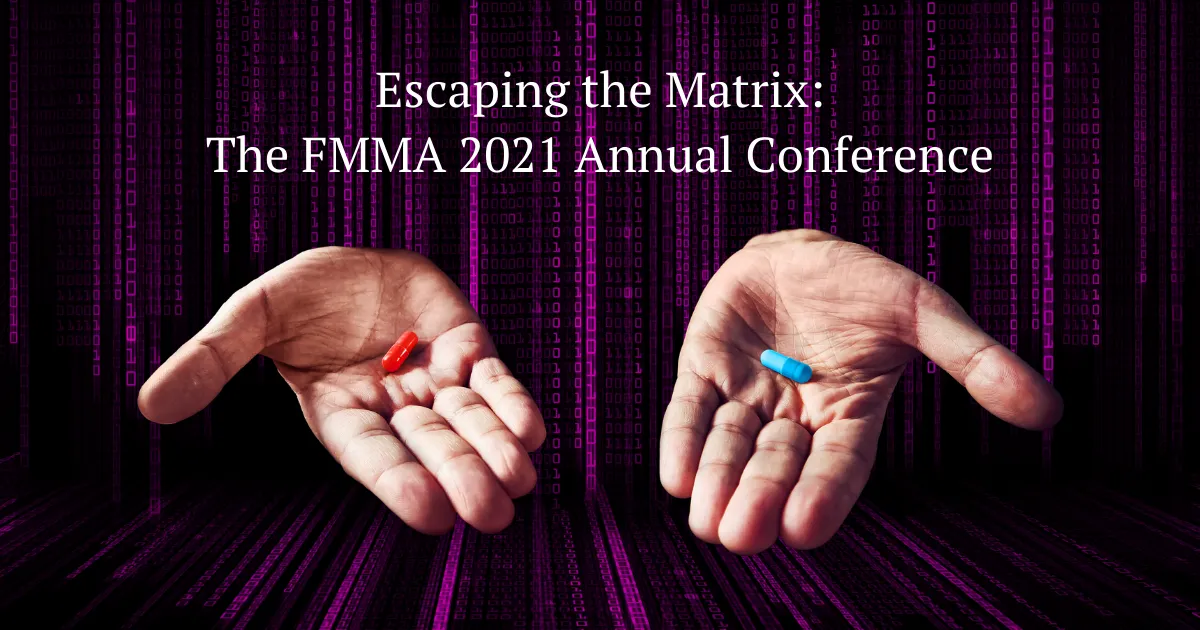Contact Us
sanantonio@fmma.org
Follow Us:
Our Blogs

Escaping the Matrix: The FMMA 2021 Annual Conference
What Does the Matrix Represent in Healthcare?
For those of us championing the cause of the Free Market in healthcare, the Matrix represents the overly complicated healthcare system that no one is supposed to know exists. This system wasn’t designed to serve you; the system was designed to frustrate and infuriate you. It’s a system where people make choices for a medical service that really do belong in a movie–like deciding which of their two accidentally severed fingertips to reattach in the Emergency Room without insurance that covers both, suturing their own kneecaps to avoid hospital care, or coming home after an unexpected $39,000 appendix removal only to wind up with even more surprise bills (albeit, with missing CPT codes) that eventually put them into bankruptcy.
This current healthcare system, which is very much alive and well, keeps people from making wiser decisions and choices that, given the chance, would reward them for being responsible, healthy, conscious healthcare consumers, as illustrated in one of our local chapter's quarterly meetings last year. The consumer that shops by proxy instead of accepting whatever fake price the hospital system (enabled by the federal government) offers them, understands how the free healthcare market works. Health care providers that dodge government regulation by opening their own physician practices for more health-care freedom understand that the value of their services is determined by market forces. This “awakening” process is essentially what breaks the healthcare matrix. Using a free market approach to shop and pay for (there’s a distinction) healthcare changes how we purchase healthcare delivery and medical services, which lowers the cost of healthcare to its true cost and fair prices. With fair price controls, healthcare providers can do their jobs, the cost of healthcare lowers, and the entire industry changes with better health outcomes.
The Matrix, Theme of the Free Market Medical Association’s 2021 Annual Conference
Steve Forbes, Dr. Tony Dale, and other dedicated individuals gave presentations focusing not only on the demand side of healthcare, (i.e. lowering the medical costs of prescription drugs and healthcare costs), but the supply side. The keynote speech Steve Forbes delivered at the conference focused on how to safeguard free markets. In his presentation, Mr. Forbes offers a new understanding of how free markets work when there is no interference from Washington politicians and special interest groups.
The Highly Uncompetitive Healthcare Market Failure
"Healthcare is a uniquely uncompetitive market because of the numerous rules and regulations that protect incumbent businesses at the expense of new competition." -PolicyEd There is a market for healthcare, but we need insanely intense competition. That means we need to talk about getting more qualified primary care doctors and doctors-to-be in school. More nurses. More young people who are still deciding on if they want to be in an overworked, underappreciated, overregulated field of medical care, or if they want to go into a free market, explaining what that means to them, screaming at the top of our lungs that insurance and healthcare are not synonymous.
We should focus on new companies and, most certainly, not neglect the lack of doctors we have in this country. When we do these things, a competitive market emerges while we are waiting on changes in policy. However, it’s still important to examine the impact of regulations in the healthcare market and the direct impact of little-to-no, or even poor, entrepreneurship in the market. You can learn more about regulation vs. entrepreneurship in Per Bylund, PhD and Dr. Cristin Dickerson’s presentation on the Matrix of Healthcare Regulation vs Entrepreneurship. (PDF notes)
Small Businesses and Healthcare
Employment-based health insurance leaves a lot of room to focus on stories and case studies that show how employer plans can work in a free market-based system. Dr. Tony Dale, Founder & Chairman of Sedera, and Elaine Parker, President of Job Creators Network Foundation & Chief Communications Officer, explain how to overcome the “bumper sticker health plan” by providing plans that are patient-centric. The goals are to repair and restore the doctor-patient relationship and get bureaucrats out of the exam room to provide choice and affordability. Engaging Company CEO’s To Drive Transformational Change in Healthcare – Tony Dale & Elaine Parker (PDF notes)
Bundled Pricing in the Emergency Room and Maternity Care
Mankind’s greatest hope now lies in us, promoters of the free market in healthcare chasing people down and offering them the red pill they never knew existed. It has been a common misconception that emergency rooms and maternity wards cannot bundle their payments. Yet, in a discussion with Keith Smith, Christion Rice, MD, MBA, and Kylie M. Mayes, they smash the myth explaining how direct care can come to the rescue providing a range of predictable costs and transparency. Publishing prices helps to empower individuals and employers that purchase health insurance to create market pressure and discourage overcharging. Maternity or Emergency Care Can’t Be Bundled, Right? Another Red Pill for You! (PDF notes)
Laws to Improve Access to Care and Affordable Healthcare Coverage With Legislation
David Balat, Director of Right on Healthcare Initiative, Texas Public Policy Foundation, and Jonathan Small, C.P.A., President, Oklahoma Council of Public Affairs gave a legislative update explaining the impact of Medicaid expansion and other updates on the delivery of healthcare for Texans. Among the updates was that the Medicaid Expansion applies to 1-1.5 million people and costs $5 billion. It now extends coverage to able-bodied working adults, crowding out access for the disabled. It also increases the use of emergency rooms for non-emergency care cases. Fewer doctors accept Medicaid, which decreases the quality of patient care. 662K uninsured Texans already have access to Medicaid, but do not use it. See the full presentation here:
Legislative Update – David Balat (PDF notes) video
Our current structure that delivers healthcare services is also responsible for a denial of care, is not price sensitive, and has no interest in operating under a free-market system. When the purchase of health insurance is continuously conflated with the delivery of care and healthcare value, there are unintended consequences. Without care improvement project measures for surgery centers, hospitals, insurance carriers, and checking the outcomes for individual patients, we cannot easily control health-care spending. Doctors are stuck with uncompensated care by central planners with no regard for sound healthcare financing. Regardless of income level, patient outcomes should be favorable, but we've got to escape the Matrix of Healthcare.
Become a San Antonio FMMA member free of charge and sign up for our newsletter to stay on top of what's happening in the Free Market Healthcare world!

Follow Us
Follow Us
© Copyright 2025. San Antonio Free Market Medical Association. All rights reserved. Site by SHANKX.
